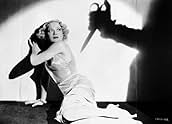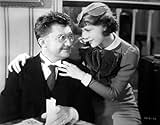Ajouter une intrigue dans votre langueA doctor who is also a "mentalist" confesses to a murder. The only problem is that the murder he's confessed to hasn't happened yet--although dead bodies are now starting to turn up all over... Tout lireA doctor who is also a "mentalist" confesses to a murder. The only problem is that the murder he's confessed to hasn't happened yet--although dead bodies are now starting to turn up all over the place. A reporter sets out to solve the "mystery".A doctor who is also a "mentalist" confesses to a murder. The only problem is that the murder he's confessed to hasn't happened yet--although dead bodies are now starting to turn up all over the place. A reporter sets out to solve the "mystery".
- Director
- Writers
- Stars
- Prix
- 1 victoire au total
- Detective
- (uncredited)
- Bridge Player
- (uncredited)
- Police Recorder
- (uncredited)
- Announcer
- (uncredited)
- Bridge Player
- (uncredited)
- Hungry Police Guard
- (uncredited)
- Police Desk Sergeant
- (uncredited)
Avis en vedette
It's exactly the sort of picture which could have garnered a real cult following. You could imagine hundreds of fans dressing up as these outrageously cliched characters: bungling cops, a cocky reporter, a femme fetale, a roguish playboy, a mad scientist and his sweet innocent daughter.
Of course, having that fabulous unsophistication of early thirties pictures, after knowing each other for about six hours, the reporter and the daughter fall instantly in love and get married - so nineteen thirties! It's certainly not your typical B picture - it's cheap, tacky, unashamedly over-acted but brilliant, brilliant, brilliant!
Although all the clues are there, you'll never figure out who the murderer is. Even if you rewind back to the bit with the murder during the minute you're invited to guess yourself, you'll chase those red herrings down the wrong path cleverly laid out to trick you. For a B picture, it's got a surprisingly clever story (it is of course based on a play so Paramount can't take all the credit) You also benefit from dynamic direction from pre Will Hay-William Beaudine and even decent, atmospheric photography like a camped-up Old Dark House.
It would never win any awards for filmmaking but if you enjoyed SCOOBY DOO, you'll love this magnificent nonsense.
The murderer is hard to guess, and this also has some interesting genre features. One is that the main suspect turns himself in before the crime. What mars this is that we have that one anti-cinematic device: the lights go out and events happen without us being able to see them. All crimes happen on-screen, but the crime itself is occluded. This happens twice, each time there is a murder.
As a narrative device, we have evolved away from this one, and I guess I am sad to see it go, because with it, you have purity: everything essential happens in front of you. But evolved away we have, to be replaced by off screen unknowns.
We have also lost the character who is our on-screen detective, but not as a result of cinematic development. These guys just faded from life in general, the newspaper crime reporter. That is a loss too.
Which, the cops inform him, isn't a crime until he does it. He goes with one of them to his home, where the patient is waiting..... and the corpses start to pile up.
It's a heck of a set-up, and a pretty good mystery in this definitely pre-code movie, in which reporter Stu Erwin falls in love instantly with Frances Dee, Hersholt's daughter and tries to solve the murder himself. With Torben Meyer, William Janney, Samuel S. Hinds as the patient and Fred Kelsey as a dumb cop.
Brandt confesses all of this because he is a moral man, is horrified by his own thoughts, and wants to be stopped before it is too late. How did things get this far? Because the moral Brandt is married to a very immoral woman, and she's been suggesting that she will leave Brandt unless their financial situation improves. The police say they can't arrest him for what he hasn't done but they will come to his house and make sure he doesn't carry out his plan. Brandt is thankful and relieved.
In spite of all of these precautions, Brandt does wind up - seemingly alone - in a room with his wife and a hypnotized Ames. The lights go out. Brandt's treacherous wife screams, hears a scuffle, then wrestles with someone in the dark, then flees into the street looking for help. The person who comes to her aid is crime beat reporter Dan McKee (Stuart Erwin). When the lights come back on Ames is dead in the manner described by Brandt in his plot, the money is gone, and Brandt lies next to Ames unconscious from chloroform.
McKee wants to bust this crime wide open for his paper, but he has to work around the police and deal with the fact that there are so many suspects - Brandt's daughter, Brandt's wife and her lover for obvious reasons, Brandt himself, the police who knew Brandt's plans, maybe even Brandt's servants - had they been snooping on private conversations?. Then there is some mystery man who shadows Brandt from the beginning of the film up to the time of the murder. Could he have done it? Brandt's daughter seems innocent enough, but she could have gotten into the house any time, plus McKee is sweet on her. Could she be the killer? What is unique and rather William Castle-like about this film is that about 15 minutes before the end the film is stopped and an announcer comes out and says that this film is moving so fast that the viewer doesn't have time to figure out who did it, so a brief intermission is declared as all of the suspects are shown on the screen while the intermission clock counts down. Then the film concludes.
I really liked this one. Although you are led to believe Jean Hersholt is going to be the lead in the beginning, it is actually Stu Erwin's picture most of the way, and he rises above his normal corn-fed supporting man image and comes across true as the hard-working crime beat reporter confident he can get the killer, get the story, and get the girl, even though it might be the girl herself or her father that he winds up sending to the electric chair.
Le saviez-vous
- AnecdotesToward the end of the film, the story is interrupted by the appearance of an announcer (played by Arthur Hohl) who states that mysteries move too swiftly for the audience to determine the villain, and for this reason a one minute intermission will be provided for them to solve the mystery on their own before returning to the story.
- Citations
Announcer: [the movie pauses and the announcer makes the following statement after which a clock appears on the screen and the numbers 1 to 60 are superimposed on the faces of the suspects] Ladies and gentlemen, the great trouble with murder stories on the screen is that the audience has no time to solve the mystery. When reading a book, it is possible to put it down at any time to think; in a play, there are intervals between the acts. But a film moves so fast that the audience doesn't have a chance to play detective. Sitting there in your seats, you have witnessed two murders. You have seen exactly how they were done and who were present. All the clues known to the police are known to you. We are trying a little experiment: we are going to give you one minute by that clock, in which to guess who murdered Philip Ames and Mrs Brandt.
Meilleurs choix
Détails
- Date de sortie
- Pays d’origine
- Langue
- Aussi connu sous le nom de
- On Probation
- Lieux de tournage
- société de production
- Consultez plus de crédits d'entreprise sur IMDbPro
- Durée1 heure 13 minutes
- Couleur
- Rapport de forme
- 1.37 : 1
Contribuer à cette page

































